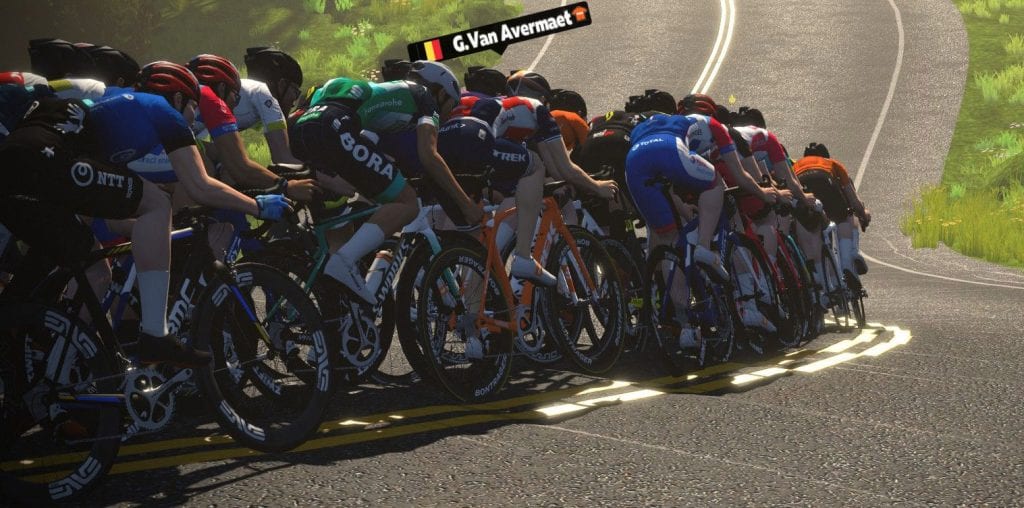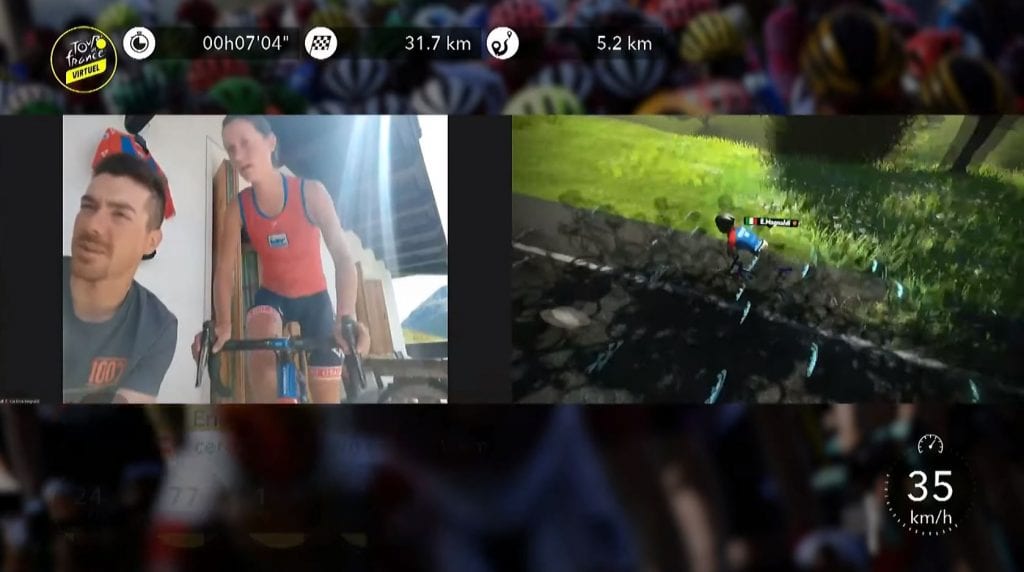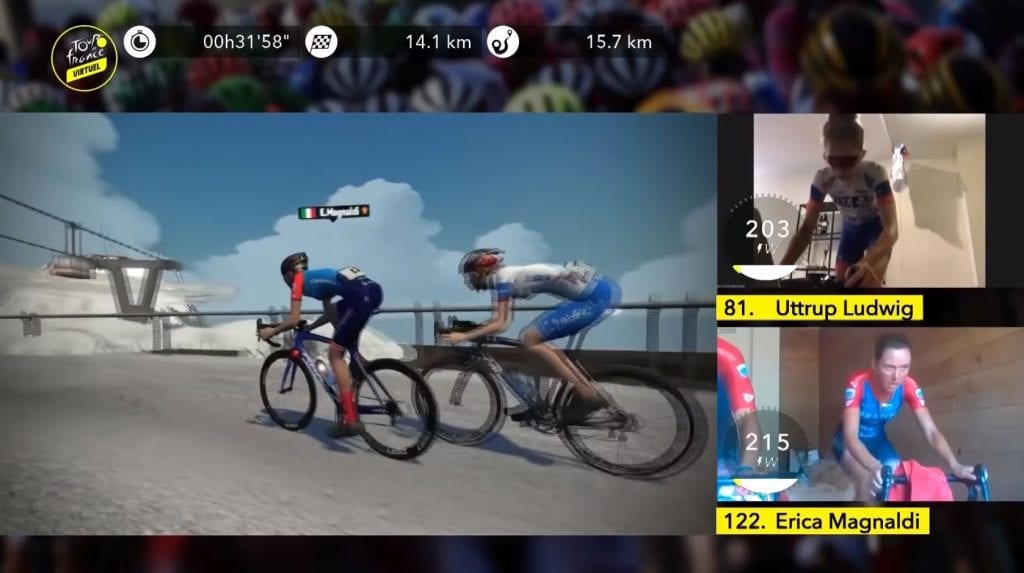This weekend saw history made as the first two stages of the 6-stage Virtual Tour de France were raced in Watopia. The men and women took on the Hilly Reverse Route for stage one, then the Mountain Route for stage two. As a huge TdF fan who has watched and ridden in hundreds of Zwift races since I first hooked up my smart trainer in November of 2015, I couldn’t wait for the vTdF to begin.
What would it look like for the world’s top pros to take on routes I’ve ridden hundreds of times, virtual roads I know like the back of my hand? And how would Zwift up their broadcast game now that they were visible on the world stage?
Needless to say, the first two stages didn’t disappoint! Here are my thoughts on stage 1 and 2 of the Virtual Tour de France.
Slow Starts?
All the commentators I heard made a point of saying something along the lines of “Zwift starts are always really hard and fast, but the pros today won’t be starting as hard as a typical Zwift race, because they’re used to the easier starts of outdoor racing.”
This makes sense – and if you watched any of the Team INEOS races in past months, you may have noted that they started in a more sedate fashion and unfolded very much like an outdoor race, with a breakaway getting away up the road, the chase group working together to keep the breakaway within striking distance, etc.
But here’s the thing: this weekend’s stages didn’t start easily. While it makes sense that they would have, that’s not what happened! My guess? There were enough experienced Zwifters in the race pushing the pace that anyone looking for an easy start got dropped… hard.
Here is stage 1 winner Ryan Gibbons’ Zwift activity. Let’s look at the first few minutes of the race: from the start to the top of the kicker before the descent to the sprint. He made it to the top of this kicker in 2:54.
Now let’s look at a few recent community races on the same route. Here’s the data from the winner of a 3-lapper. He made it to that same point in 3:08. 14 seconds slower, across just three minutes! And that’s the fastest start I could find in a community race (although admittedly, I didn’t spend hours looking, and the tools to search are pretty rudimentary). Most races took more like ~3:20 to get to that same point. My best time ever was 3:13 to that point. Humbling.
So the pros started hard. And they kept going hard to the end! (See “Lap Times” below for more on that.)
Showing the Start
The video streams skipped the start of the first three races, only showing it for the fourth race of the weekend – men’s stage 2. I’m not sure what the reasoning is behind this, as the start is a crucial part of these races. Perhaps they thought the starts would be boring, like a neutral start or some sort of grand départ. But these are sub 1-hour races on Zwift – ain’t nobody got time for easy starts!
Hopefully Zwift will televise the starts of races moving forward – and hopefully the commentators can communicate the crucial moves going on in those first few minutes, when a good portion of the field gets whittled down as stronger riders push it at the front.
Zwift Raceview
Have you seen Zwift’s web-based “Raceview” tool? I just happened to come across a link to it, but it hasn’t been publicized much as far as I can tell. This is the start of something really cool! It shows the riders’ positions on course, and lets you click to select a rider to view their particular position. Here’s a quick video of me poking around in Zwift Raceview during the men’s stage 1:
Of course, I see a tool like this and think of 10 things I would add. I would love to see additional stats for riders: some power numbers, heart rate, etc. I want to be able to click on a circle and see who it is. And a live points view would be really useful, so we can see where each team stands as they hit point segments.
But still, in its current state, this is a useful tool with tons of potential! See it at zwift.com/raceview.
Lap Times
Curious whether these riders were really giving it their all? Wondering just what kind of performance a top-level pro can put out?
Check out the Strava leaderboard for the “Hilly Route Reverse from Start Gate” segment, and you’ll see that only 6 entries in the top 25 are from events outside of Saturday’s vTdF race. This was a pack of top-level pros pinning it. In fact, 37 of the top 50 slots are now taken by vTdF riders.
And the same happened on stage 2! The leaderboard for “Mountain Route Forward 1 Lap from Start Pier” shows 10 of the top 11 spots taken by the riders who attacked hard up the climb and got away in stage 2. Not bad, considering 51,800 riders have their times ranked on this segment.
The Pros are Learning
In past high-level races which included veteran Zwift community teams as well as pro riders it was clear that the pros lacked Zwift experience. We’d see them hammering on the front then blowing up, using powerups at the wrong time, or getting caught out on small climbs on routes they clearly didn’t know well.
But the pros are learning. I suppose that’s what a couple months of forced indoor training will do to a rider! Watching the broadcasts it was clear that many of the riders knew their way around powerups, the supertuck, and other details that newbies struggle to grasp.
Wheels and Frames
Zwifters know that in-game frames and wheels perform differently, since they’re given particular characteristics which change their aerodynamics and weight. Race commentators (and ZwiftHQ, in the stream chats) mentioned that all of the riders’ bikes were set up with the same performance characteristics.
I found this interesting, since it hadn’t been common practice in past Zwift eSports events. I was also curious how this worked, since it was clear that different teams were riding different frames and wheelsets in the vTdF competition. (They weren’t just “skinned” differently – they were actually different frame designs. And wheels clearly varied between riders.) Here’s a screenshot of the men’s stage 1 race where you can clearly see different frames and wheelsets being used:

Here’s what ZwiftHQ said in response to my query:
For the Tour de France we have neutralised all in-game equipment to ensure all the teams are on equal standing. Bikes and wheels share the same characteristics. We actually did the same for the Tour for All. Due to time restrictions, we weren’t able to build all the team bikes, so some of the teams are riding Zwift bikes with skins.
While neutralizing equipment for all Zwift races doesn’t seem like a good idea (it adds a fun element of strategy to the game, and Zwifters need incentives to keep unlocking new stuff!), it makes good sense in the vTdF. It would leave a bad taste in many mouths to learn that riders with more Zwift XP were given a speed advantage.
Drafting Tweaks
It’s also been mentioned that the draft was somehow modified for these races. This is big news, since the draft is a cornerstone feature of Zwift racing.
Here’s what ZwiftHQ said about it:
For the drag question, we often experiment with the algorithms relating to in-game physics. Ahead of the Tour de France, we ran a number of community test events with new drafting algorithm. The new draft makes it easier in the wheels and help to encourage a more aggressive style of racing.
I’d love to get more details – but that’s all I’ve got! It would be really interesting to know what specifically was tweaked. It sounds like the draft effect was increased (“easier to sit in the wheels”) but is that all? Is it just the double draft?
Surely it’s more than that, because Zwift would have learned by now that simply the increasing the draft effect (e.g., Double Draft) doesn’t encourage a more aggressive style of racing, since it increases overall pack speeds and makes it harder to get away and stay away. Perhaps they changed the level of draft stickiness so there’s less churn on the front, reducing the overall pack speeds?
Camera Angles and Views
Clearly Zwift made a pile of improvements to its broadcasting tools for the vTdF. New camera angles made watching the race action more engaging – there were at least a couple of new sort of “elevated moto” angles that worked really well.
I especially liked the “single rider camera” mode where all other riders were ghosted out. It really let you see what that particular rider was doing, and was especially powerful when coupled with live view like they did with Erica Magnaldi in stage 1 (see below).

Lower Numbers, Higher Excitement
One sentiment I’ve seen echoed in the Zwift community (and one I agree with) is that these races are much more fun to watch when the number of riders is low. Watching a mass of even 20 riders just isn’t interesting – there’s so much churn happening in the pack that you can’t pick out who is who, which riders are putting in good work on the front, etc.
But whittle that down to a group of 5-10, and you’ve got a race on your hands. Now you can see which riders are doing what, and things become much more engaging.
Zwift made a good decision in limiting teams to just 4 riders, which keeps the overall pack size down. And the sprint and KOM points help encourage attacks, which helps to string out and break up the group somewhat. But nothing breaks up a group like a 10-15 minute climb! The race got really interesting once riders neared the top of the epic KOM and made their way onto the radio tower in stage 2.
More Live Video
Showing a live rider on screen while we see their avatar in-game is significantly more engaging than the game view on its own. I hope Zwift works to increase their usage of quality live feeds, because it really takes the broadcast to the next level!
My favorite live stream moment was when we get to watch Ludwig and Magnaldi as they battled their way up the radio tower climb in the women’s stage 2. Ludwig in her sunglasses, Magnaldi and her incredible strength – with wattage and heartrate shown along with the live video, we could see the riders in (arguably) a more intimate way than we ever would in an outdoor race. And that’s a big deal.

Conclusions
Zwift has upped their broadcast game heading into the vTdF, and it shows. Pro riders, as well, are clearly much better Zwift racers than they’ve been in the past. With everyone striving for Tour-level excellence, the experience for spectators will continue to improve. So I’m looking forward to next weekend!
Your Thoughts
I’d love to hear what you thought of stages 1 and 2. Share below!

